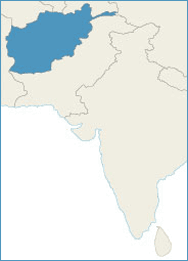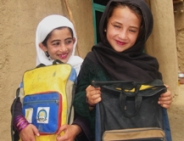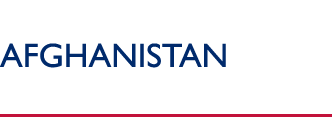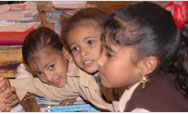 |
|
 |
 |
|
 |
 |
|
 |
 |
 |
| USAID
Information:
External Links:
|
|
 |
 |
|
 |
 |
|
 |
 |
|
Afghanistan

SNAPSHOT
Date of independence: 1919
Capital: Kabul
Population: 30 million
GDP per person: $250
Source: World Bank Development Indicators
USAID IN AFGHANISTAN
afghanistan.usaid.gov
CONTACTS
Mission Director
Robin Phillips
USAID/Kabul
6180 Kabul Place
Dulles, VA 20189-6180
Tel: 873-762-311955
Email: apsobangkok@usaid.gov
www.usaid.gov/afghanistan

By the end of 2006, the
accelerated learning program had
enrolled over 170,000 students,
more than half of which were girls
who were denied an education
under the Taliban. (Photo: USAID/Afghanistan)
Overview
Nearly twenty-five years of war and violence
devastated Afghanistan's polity, economy, and
society. In 2001, when the Taliban was forced out
of power, half of Afghanistan's people lived in
absolute poverty, and virtually all of the country's
institutions and much of its infrastructure were
destroyed.
To rebuild the country and combat
terrorism, USAID is working to create economic
growth, effective and representative governance, and the human capital
base needed to eliminate the conditions that breed extremism.
Programs
Economic Growth
Functioning transportation and electricity networks are essential for
economic growth. Roads connect farmers to markets, provide access to
health facilities, and facilitate regional trade. Road construction has been a
major reconstruction priority. As of spring 2007 USAID had completed
rehabilitation of more than 1,500 km of roadway nearly half of which was of
the Ring Road, the country's principal transport artery.
Access to reliable, affordable power is critical to building a vibrant private
sector, yet less than 10 percent of Afghans have access to electricity. USAID
is working to remedy this situation by supporting the North-East Power
System, a multi-donor initiative that will provide expanded access to reliable,
low-cost electricity. USAID is also improving thermal electrical generation
facilities for major cities, including Kabul, and rehabilitating the Kajaki Dam,
the principal source of electricity in southern Afghanistan.
Rebuilding Afghanistan's legal rural economy is key to economic growth,
since an estimated 80 percent of Afghans earn a living through farming.
USAID's improvements to Afghanistan's irrigation systems have improved
irrigation for nearly 10 percent of the country's arable land and improved the
health of millions of heads of livestock. USAID is helping Afghanistan
develop a market-driven agricultural sector by improving linkages between
suppliers, producers, and markets, and providing farmers with improved farm
technologies and increased access to financial services.
Additional economic growth programs are assisting Afghanistan's
businesses with credit, training, and other support services. Land titling and
property rights are being strengthened, while moribund state-owned
enterprises are being privatized. These activities are generating investment,
strengthening businesses, and creating job opportunities. Importantly, USAID
also works with the government of the Islamic Republic of Afghanistan to
increase revenue collection, improve the legal and regulatory framework for
the private sector, and build capacity within the government to manage the
economy.
Governing Justly and Democratically
Afghanistan has made significant strides towards democracy since the fall of
the Taliban. In five years, the country has drafted a new constitution and
democratically elected a president, National Assembly, and provincial
councils. Going forward, USAID support will focus on building the capacity of
democratic institutions to improve governance and the quality of public
services at the national and sub-national levels. USAID also works to
strengthen civil society, including independent media and non-governmental
organizations.
In Afghanistan, Provincial Reconstruction Teams (PRTs) have assisted with
the delivery of U.S. and international assistance at the provincial level. PRTs
are small, joint civilian-military teams designed to improve security, extend
the reach of the Afghan government, and facilitate reconstruction in priority
provinces.
Investing In People: Health and Education
In 2002, when schools first reopened, ninety-seven percent of the country's
girls did not attend school. By the end of Taliban rule, 80 percent of existing
schools were either severely damaged or destroyed. To improve the
situation, USAID has constructed or refurbished over 670 schools and
distributed textbooks, school supplies and training materials. USAID created
an accelerated learning program that enrolled over 170,000 students, more
than half of which were girls. USAID also works to improve the quality of
teaching, management, and information systems at Afghan universities, and
teacher training through radio broadcasts reaches 65,000 teachers daily in
all 34 provinces.
The health status of Afghans is among the worst in the world - one out of
every five Afghan children dies before the age of five. To provide Afghans
with access to basic health services, USAID has constructed or refurbished
over 670 clinics throughout the country, established over 3,000 health posts,
and supports the operations of 360 health facilities, including the provision of
all medicines and expendable supplies. USAID has also trained over 1,000
midwives to work in hospitals and clinics throughout the country, which has
helped reduce maternal and infant mortality.
Back to Top ^
|


